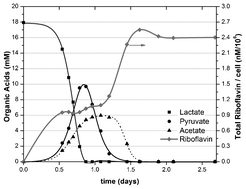A study of the flavin response by Shewanella cultures in carbon-limited environments
Abstract
Mediated electron transfer has been implicated as a primary mechanism of extracellular

* Corresponding authors
a
Department of Chemical and Nuclear Engineering, Centre for Emerging Energy Technologies, The University of New Mexico, Albuquerque, NM
E-mail:
plamen@unm.edu
Tel: +1 505 277-2640
b Airbase Sciences Branch, Air Force Research Laboratory, Tyndall Air Force Base, FL
c Universal Technology Corporation, Dayton, OH
d Department of Earth Science, University of Southern California, Los Angeles, CA
e The J. Craig Venter Institute, San Diego, CA
Mediated electron transfer has been implicated as a primary mechanism of extracellular

 Please wait while we load your content...
Something went wrong. Try again?
Please wait while we load your content...
Something went wrong. Try again?
J. N. Roy, H. R. Luckarift, C. Lau, A. Falase, K. E. Garcia, L. K. Ista, P. Chellamuthu, R. P. Ramasamy, V. Gadhamshetty, G. Wanger, Y. A. Gorby, K. H. Nealson, O. Bretschger, G. R. Johnson and P. Atanassov, RSC Adv., 2012, 2, 10020 DOI: 10.1039/C2RA21727A
To request permission to reproduce material from this article, please go to the Copyright Clearance Center request page.
If you are an author contributing to an RSC publication, you do not need to request permission provided correct acknowledgement is given.
If you are the author of this article, you do not need to request permission to reproduce figures and diagrams provided correct acknowledgement is given. If you want to reproduce the whole article in a third-party publication (excluding your thesis/dissertation for which permission is not required) please go to the Copyright Clearance Center request page.
Read more about how to correctly acknowledge RSC content.
 Fetching data from CrossRef.
Fetching data from CrossRef.
This may take some time to load.
Loading related content
